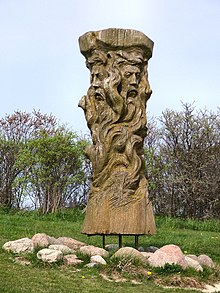Swiatowid
| Svetovid | |
|---|---|
| God of war, fertility and abundance, supreme deity | |

|
|
| Abode | temple at Arkona, Rügen island |
| Symbol | four heads or faces, white stallion, horn of plenty, sword |
| Mount | white stallion |
Svetovid, Svantovit or Sventovit is a Slavic deity of war, fertility and abundance primarily venerated on the island of Rügen into the 12th century. He is often considered a local Rugian variant of the pan-Slavic god Perun.
Sometimes referred to as Beli (or Byali) Vid (Beli = white, bright, shining), Svetovid is associated with war and divination and depicted as a four-headed god with two heads looking forward and two back. A statue portraying the god shows him with four heads, each one looking in a separate direction, a symbolical representation of the four directions of the compass, and also perhaps the four seasons of the year. Each face had a specific colour. The northern face of this totem was white (hence White Ruthenia / Belarus and the White Sea), the western, red (hence Red Ruthenia), the southern, black (hence the Black Sea) and the eastern, green (hence Zeleny klyn).
Boris Rybakov argued for identification of the faces with the gods Perun, Svarog, Lada and Mokosh (compare Zbruch idol). Joined together, they see all four sides of the world. This gave rise to a false etymology of the name of the god as "world-seer" (svet = "world", vid = "sight"; Svetovid = "worldseer"). However, the forms Sventevith and Zvantewith show that the name derives from the word svętъ, meaning "saint, holy". The second stem is sometimes reconstructed as vit =,"lord, ruler, winner".
The name recorded in chronicles of contemporary Christian monks is Svantevit, which, if we assume it was properly transcribed, could be an adjective meaning approx. "Dawning One" (svantev, svitanje = "dawning, raising of the Sun in the morning" + it, adjective suffix), implying either a connection with the "Morning Star" or with the Sun itself.
...
Wikipedia
